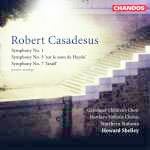
Symphonies Nos 1, 5 & 7
 $40.00
Out of Stock
$40.00
Out of Stock6+ weeks add to cart
ROBERT CASADESUS
Symphonies Nos 1, 5 & 7
Natasha Jouhl soprano, Alexandra Gibson mezzo-soprano, Mark Wilde tenor, Northern Sinfonia Chorus. Northern Sinfonia.Howard Shelley
[ Chandos Classics / CD ]
Release Date: Friday 15 July 2005
This item is currently out of stock. It may take 6 or more weeks to obtain from when you place your order as this is a specialist product.
"Performances excellent though in truth the music is variable. I warmed to the warmth and piety of the last, late symphony but the First is the strongest"
(MusicWeb Feb 2007)
It is often the case that a musician's exceptional gifts in one area will eclipse his other, equally remarkable abilities. Robert Casadesus is a case in point. Three thousand concerts, more than a hundred recordings and a star on the Hollywood Walk of Fame would be ample proof, if it were needed, that Robert Casadesus was one of the twentieth century's greatest pianists. It is less well known, however, that he left a remarkable catalogue of compositions in a neo-classical, often modal idiom, many of which have never been recorded. His compositional abilities were recognised by many of his contemporaries, including Ravel, which makes it all the more strange that his work has been so neglected. Conductor Howard Shelley, himself a pianist of international standing, proves himself to be a worthy advocate of Robert
Casadesus's music in this recording.
A disc consisting entirely of premiere recordings.
Pianist Howard Shelley has made over fifty recordings for Chandos. His work is consistently well reviewed, and many of his discs have been Editor's Choices in Gramophone. He is also increasingly making his name as a conductor - his disc of Hummel's mandolin and trumpet concertos was especially well received.
"Robert Casadesus studied piano with Louis Diémer (who had himself been a pupil of Liszt) and won his first prize at the age of fourteen. He composed his first work when he was seventeen. Fifty years later, his bequest to posterity was a catalogue that had grown to sixty-nine works. Though as a pianist he performed the music of his contemporaries, he never concealed his taste, as a composer, for music of the classical era. Contemporary trends such as serialism did not suit him. He once remarked, 'I look to Fauré, Roussel and Saint-Saëns as my models, for their form is absolutely classical'.
Symphony No. 1 was composed in 1935. It already contains the hallmarks of Casadesus's compositional style: the music is forthright and well-crafted structurally and reveals the particular fondness he had for writing for the woodwind section. Symphony No. 5, composed in 1959, reveals another facet of Casadesus's musical personality, namely his desire to bring to wider public notice certain composers whose work was seldom performed in the first part of the twentieth century. The symphony was written to mark the 150th anniversary of the death of Haydn and his homage takes the form of a musical theme made up of the letters of Haydn's name, and in the formal and proportional conception of the symphony. Symphony No. 7 is Casadesus's last completed work. He wrote it as a tribute to the people of Israel and more precisely to the historical events associated with the Six Day War. Already ill, and deeply affected by the death of his son in January 1972, Casadesus found the strength to attend a read-through of the symphony in New York in April. He died on 19 September, and the emotionally charged first performance, dedicated to his friend George Szell, was given two months later."
Tracks:
Symphony No. 1, Op. 19 (1934-1972)
Symphony No. 5, Op. 60 'sur le nom de Haydn' (1959-60)
Symphony No. 7, Op. 68 'Israël' (1967-70)